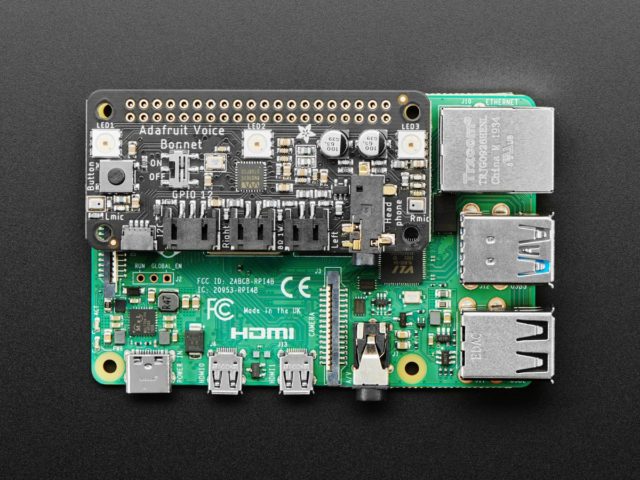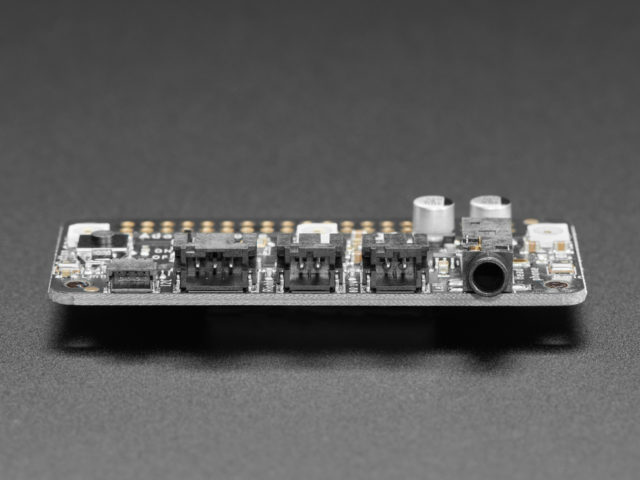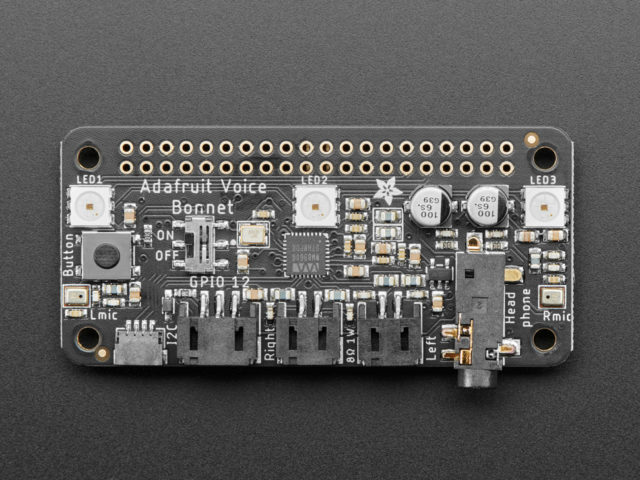Adafruit Voice Bonnet features two speakers and two mics, that can be used as an audio-voice interface for Raspberry Pi SBC to create a DIY smart speaker or other audio product. The voice bonnet can work with any Raspberry Pi from Pi Zero up to Pi 4, with 40-pin 2 x 20 connector. Two speaker outputs of the voice bonnet have a power rating of 1 Watt. The voice bonnet contains 3.5 mm stereo outputs, headphone stereo, or line-out audio.

The Adafruit voice bonnet has an on-board WM8960 low-power stereo codec that uses I2S digital audio for both input and output. The WM8960 codec has a dual analog input, it consists of a left mic and a right mic. The codec integrates a complete microphone interface and a stereo headphone driver.
Adafruit says “For DIY speakers, solder any 1W+ speaker to one of these JST 2-PH cables. If you’d like to stack another HAT or bonnet on top, use a 2×20 stacking header to feed through the 2×20 connector.”

Additional Voice Bonnet Features
- Push-button: This button is used to change modes, activate the voice assistant, and configuring user-specific functions.
- Three DotStar RGB LEDs: These LEDs can be used for adding visual feedback or making a rainbow light show.
- STEMMA QT connector: This connector is used to plug in I2C sensors, OLEDs, or accessories.
- 3-pin JST STEMMA connector: This connector is for larger accessories such as servos, relays, or NeoPixels.
- On/Off Privacy Switch: This switch allows to manually deactivate the audio, this ensures the device is not recording anything.

Conclusion
The Adafruit voice bonnet is meant to be easy to use, as no assembly is required. It can be simply popped in with the Raspberry Pi SBC. The microphone/speaker card software can then be installed with the Installer script. The On/Off privacy switch allows manual control of audio input.
The audio output gives the choice of using the line-out headphone stereo jack or plugging in one or two of the enclosed speakers. I2S digital audio enables high-quality music playback and audio recording, and Adafruit claims the audio is “better than the headphone jack on the Pi (or the no-headphone jack on a Pi Zero)”. The voice bonnet is specifically designed for machine learning projects like DIY voice assistants. It can also be used to create “various voice-activated or voice recognition projects.”
You can find more about Adafruit’s Voice Bonnet on the official product page. There is also a separate GitHub repository for the voice bonnet PCB. It is available on Adafruit’s website for $14.95. For people more interested in computer vision applications, Adafruit also offers BrainCraft HAT, but at this time it is out of stock.

Saumitra Jagdale is a Backend Developer, Freelance Technical Author, Global AI Ambassador (SwissCognitive), Open-source Contributor in Python projects, Leader of Tensorflow Community India and Passionate AI/ML Enthusiast
Support CNX Software! Donate via cryptocurrencies, become a Patron on Patreon, or purchase goods on Amazon or Aliexpress





Interesting development but doesnt seem too intelligent or added ability like discerning human accents & language recognition (open source would be great, but I fear monopolist desires short circuiting such hopes as corporate interests tend to dominate in a barrier inducing way), which would be critical in many applications.